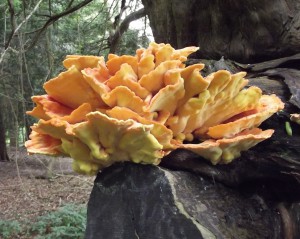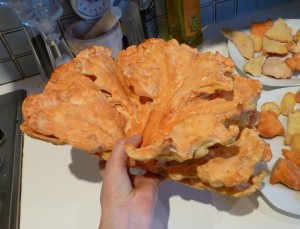17/06/2013
“Where poisoning does occur, in animals or humans, there may be no symptoms and death may follow within a few hours of ingestion. If symptoms do occur, they include trembling, staggering, coldness, weak pulse and collapse” (from www.thepoisongarden.co.uk, in reference to yew.)
First, the easy bit. Chicken of the woods (sulphur polypore/shelf, Laetiporus sulphureus) is a bracket fungus, fairly common in the UK and just coming into season now. Unlike most wild fungi, the danger associated with this species has nothing to do with identification; it’s easy to identify, because of its bright colours and distinct smell, and the only things you could conceivably mix it up with aren’t poisonous. It’s also, when still young, fresh and tender, absolutely delicious – it’s right up there with chanterelles and penny buns in the premier league of edible wild fungi.
So what’s the problem? It often grows on yew is the problem. It grows on plenty of other trees too, with a preference for oak, chestnut, cherry and willow, but I probably see it on yew more often than any of these others – and yew is associated with more than its fair share of mystery and mythology of its own, and rightly feared for its toxicity, which some people claim is transferred to the fungus when it grows on this tree. Chicken of the woods is also claimed by some sources to cause problems in a significant minority (5-15%) of the population even if it isn’t growing on yew, although some people to believe the two situations are linked, and that the minority in question have unwittingly eaten chickens from yew.
Last week, people all over the UK started posting pictures of chicken of the woods; 2013 is a good year for this fungus. One individual posted a picture of a very large specimen growing on yew, and in addition to having eaten some without coming to harm she also stated that she knew somebody who had been collecting and eating the fungus from the same tree for the last twenty years, with no ill-effects! So yesterday morning I decided to go for a long walk in a chunk of ancient yew woodland in Sussex to see what I could find, and I found chicken of the woods in abundance. Time, I thought, to kill two birds with one stone. It’s a long time since I found a large amount of this species in an edible state and not growing on yew, and I’ve not had much of a chance to experiment with different recipes. I’ve also never consumed a large quantity growing on yew.
I say “walk”, but “scramble” would be more appropriate, as the woodland in question sits on the steep, scarp slope of the downs, and the ground is covered in loose chalk and flint. I lost my footing at one point, slipped over and cut the heel of my hand. The wound was a bit bloody and messy, I had no means of cleaning it, and by then I was keen just to get back to my car without having any more accidents, with my booty and camera intact. It was only as I was driving home that I realised the wound was hurting more than expected. I stopped, and on close inspection I found a small yew needle buried in my hand. As soon as I plucked it out, the pain stopped. A brief internet search will produce many anecdotal reports of a similar nature: yew foliage is potently unpleasant stuff.
Therefore, if you’re contemplating eating chicken of the woods from yew then you’d better make damned sure you remove every last scrap of foliage and bark from the surface first. Like all bracket fungi, this species will incorporate debris as it grows, and if the debris in question is yew foliage or bark then you’re eating yew foliage and bark, and there’s no question about the danger inherent in that; the toxins in yew do not break down when the plant material dies/dries!
So I cleaned it, very carefully. I then spent the next hour or so experimenting with recipes. I tried it with various different herbs and things (rosemary, thyme, chives, onion), fried with butter or olive oil, served with white toast or brown toast, on its own or covered in cream, etc… By the time I’d finished I’d eaten at least three times as much as would be consumed in an ordinary meal. I can report my findings: my favourite combination was to cook it in butter for 3 or 4 minutes, then add a generous helping of chives and finish it off with some double cream, then serve with brown toast. Truly scrumptious! I then lay down for a nap and to let my dinner get down…and wait to see if I developed any nasty symptoms or dropped dead with no warning.
I’m still here. I experienced no unpleasant effects whatsoever, and decided to cook up another load for my other half when she came home later that evening. I also had to have some more myself, of course. Would have been rude not to…
I am not going to recommend that other people go out and consume chicken of the woods growing on yew. My experiment is not absolutely conclusive. It is possible (likely, even) that some individuals are more sensitive to the toxins than others (if you have a history of heart problems then you should definitely steer clear). It is also possible that some specimens end up containing more tree-originating toxins than others. However, I suspect that yew material incorporated into the fungus is much more likely to lead to problems than the fungus itself.
I, for one, will be eating chicken of the woods from yew again. I will also offer it to my friends, although I’ll ask them to read this first.
Keep safe,
Geoff



